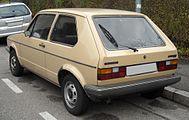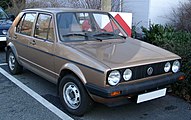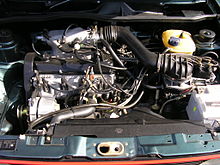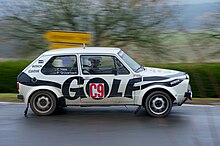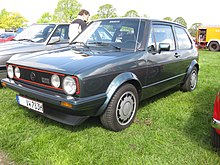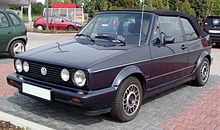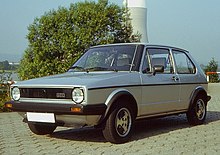VW Golf I.
| Volkswagen | |
|---|---|
|
VW Golf (1974)
|
|
| Golf sedan (type 17) | |
| Sales designation: | Volkswagen Golf Volkswagen Citi Volkswagen CitiGolf Volkswagen Rabbit Volkswagen Caribe unofficially "Golf I" and "Golf Mk I" |
| Production period: | 1974–1983 (Germany) as Citi in South Africa until 2009 |
| Class : | Compact class |
| Body versions : | Station wagon , convertible |
| Engines: |
Otto engines : 1.1–1.8 liters (37–82 kW) Diesel engines : 1.5–1.6 liters (37–51 kW) |
| Length: | 3705 mm |
| Width: | 1610 mm |
| Height: | 1390-1410 mm |
| Wheelbase : | 2400 mm |
| Empty weight : | 750-805 kg |
| Previous model | VW 1303 |
| successor | VW Golf II |
The Golf I is a car model of Volkswagen AG , and came in the spring of 1974 on the market. Together with the Passat , presented in mid-1973 , the Golf led the Volkswagen group out of the sales crisis that had existed since the early 1970s . The model contributed to the spread of the compact class after there had been some conceptual forerunners such as the Simca 1100 (from 1967). In the VW program, the Golf was supposed to replace the VW Beetle , which remained in the German VW range until 1985.
Six million Golf sedans were built between May 1974 and August 1983 , including one million with a diesel engine . In addition, Karmann produced almost 389,000 convertibles from March 1979 to August 1993 . The VW Caddy pickup, derived from the Golf I, was manufactured 200,000 times.
The factory code of the Golf I is Type 17 , the factory code of the Golf I Cabriolet is Type 155 .
Model history
development
Developed under dramatic conditions, the Golf, together with the Passat, led the Volkswagen group out of the crisis. By the end of the 1960s, VW boss Heinrich Nordhoff had relied on the Beetle and the designs derived from it with air-cooled rear engines, which customers accepted less and less.
Nordhoff's successor, Kurt Lotz , pioneered a new concept with water-cooled engines and front-wheel drive , after import brands such as Fiat , Renault , Peugeot and Simca had already presented compact models with front-wheel drive in the 1960s, and Citroën with the Citroën 2CV in 1949. The preparations The new VW boss Rudolf Leiding stopped at the end of 1971 for the series production of the Beetle successor EA 266 with a mid-engine engine developed by Ferdinand Piëch at Porsche KG (the water-cooled engine was installed lengthways under the rear seat) . The EA 276, a test vehicle, was built as early as 1969 with front-wheel drive and air-cooled boxer engine, which was further developed as the EA 337 for the Golf. At the same time, Leiding was initially not convinced by this concept, as the designer Giorgio Giugiaro later recalled: "In principle, Leiding came too late to be able to prevent the Golf."
The technological and personal competence for the Golf came largely from Auto Union and NSU : In particular, the developers at NSU, which merged into Audi NSU Auto Union AG in 1969 , such as development chief Hans-Gerd Wenderoth and Werner Holste , developed engine developers with Franz Hauk at Auto Union in Ingolstadt, the first Golf.
The new design with front-wheel drive and water cooling represented a completely new concept compared to the Beetle. In terms of utility value, the Golf with the transversely installed engine offered the best opportunity to offer the greatest possible transport benefits with the shortest vehicle length. The designer Giorgio Giugiaro gave the Golf its distinctive appearance, adaptations such as B. the change to round headlights was made at VW by Herbert Schäfer . Today, the model is considered an outstanding example of consistently modern design .
Series production began at the Wolfsburg plant on March 29, 1974 . Two engines were available for the Golf presented in May 1974: a 1.1-l engine with 50 hp (37 kW) as in the Audi 50 and a 1.5-l engine with 70 hp (51 kW) from the Audi 80 . The sales success was great from day one. At the time, the Golf was considered sporty, even with the smallest engine. Nevertheless, the engines were economical, a criterion that was very important when entering the market under the impression of the first oil crisis in 1973/74 . The standard consumption of the 50 hp engine according to DIN 70030 was 6.4 l per 100 km at 90 km / h and could be reduced to 5.2 l with Formula E equipment. The oil crisis tended to increase the demand for compact cars, which until then had come almost exclusively from Italy or France: as spacious hatchbacks with three or five doors.
Since that time, the Golf has led the German registration statistics, with a brief interruption by the Mercedes-Benz W 123 in 1980.
Facelift
In the summer of 1978 the Golf I was slightly redesigned. The vehicles can be recognized by their energy-absorbing plastic bumpers. In addition, the rust protection was significantly improved, as early Golf models quickly corroded due to the inferior recycled steel sheet used at the time.
This was due to the relatively high copper content in the metal, which led to intergranular corrosion . In the mid-1970s there was ruinous competition on the steel market due to worldwide overcapacity and led to the steel crisis . For cost reasons, some producers used a high level of impure recycled steel in their crude steel production, which VW obtained in part from the former GDR through compensation deals . Sometimes the steel scrap that was delivered was no longer fractionated: melted down cable harnesses from vehicle wrecks then led to a high copper content in the steel produced. But nickel, aluminum and chromium also contaminated the steel. As a result, this was then very susceptible to corrosion.
In August 1980 there was another revision. The Golf received wide taillights and a new dashboard. In addition, the model range was rearranged: the equipment variants were now C , CL and GL . From June 1982 onwards, the corrosion protection was further expanded with the installation of front wheel arch liners (inner fenders to protect against stone chips). The GTI was now available with five doors.
The presentation of the special models Pirelli-GTI as well as LX and GX heralded the end of production of the Golf I in Europe: after more than 6 million units were produced, the successor VW Golf II was presented in August 1983 .
Golf Diesel
In September 1976 the Golf Diesel appeared, a new concept for Germany at the time, to accommodate the diesel engine, which was considered cumbersome, loud and uncultivated, in a compact car. Until the introduction of the diesel engine for the Golf, diesel engines were uncommon in compact cars with the exception of Peugeot. The Golf Diesel with an output of 50 PS / 37 kW was one of the most economical compact cars of the 1970s with a DIN consumption of 6.5 liters / 100 km.
The diesel engine was derived from a well -known short Otto engine ( EA827 ) from Audi . Compared to this, the cooling system and some components such as the crankshaft , connecting rods , pistons , piston pins , cylinder heads and toothed belts , which have to withstand higher loads in diesel engines, have been reinforced. The cylinder head was provided with swirl chambers. A vacuum pump for the brake booster was placed at the point of the ignition distributor , which is not required for diesel . The distributor injection pump (VESP) was operated via the existing toothed belt drive of the camshaft . This meant that the diesel engine was no larger than the 1.5-liter gasoline engine.
The diesel engine initially had a displacement of 1.5 liters with an output of 50 hp (37 kW), then 1.6 liters with 54 hp (40 kW). The running behavior (noises, vibrations), especially of the first two diesel engine generations, was not yet satisfactory. The turbocharger of the first 70 hp diesel engine then brought more noise comfort through the damping in the exhaust tract.
Golf GTI
In September 1975 Volkswagen presented the first Golf GTI at the IAA . It was equipped with the 110 hp (81 kW) engine from the Audi 80 GTE , had internally ventilated disc brakes at the front and an additional oil cooler. The front axle received a stabilizer and a load-dependent brake force regulator was mounted on the rear axle. Taking its performance into account, the GTI received a brake booster from the start. The sports steering wheel had three perforated spokes - the deep baffle with the horn was soon referred to as the "spittoon". The gear knob was designed as a golf ball. Fender flares made of plastic, a larger front spoiler, tires of size 175/70 HR 13, a red-framed radiator grille and the rear window framed with black adhesive film were further characteristics of the strongest Golf model at the time.
The Golf GTI offered a powerful engine in a compact and everyday car that was affordable for the general public. Equipped with the mechanical injection system K-Jetronic from Bosch , a 1.6 liter engine and 110 PS (81 kW) output with an unladen weight of 810 kg, the Golf GTI was able to compete well with the performance of the competing models Ford Escort RS and Opel Kadett GT / E keep up. The top speed was stated as 182 km / h , the acceleration from 0 to 100 km / h in 9.2 seconds.
Contrary to the opinion of many VW marketing people, the first GTI became a bestseller and paved the way for later so-called "hot hatches" - sporty compact cars with relatively high performance. The guy has cult status today and was a popular object of tuning fans . Production started in 1976 with a four-cylinder engine with 1.6 liter displacement and 110 hp (81 kW), which was replaced in 1982 by one with 1.8 l and 112 hp (82 kW). The basic price of the first version in 1976 was DM 13,850; the 1.8-liter model last cost 20,465 DM in 1983. At the end of Golf I production, the special “Pirelli” model came onto the market in May 1983. For 22,800 DM it was available in the colors Mars red, Lhasa green metallic, alpine white and Helios blue. Green colored glazing, Pirelli light alloy wheels with 185/60 / HR14 Pirelli P6 tires and fender flares painted in the body color, bumpers and exterior mirrors were included. The "Pirelli Golf" had the VW equipment code W65.
In order not to scare off potential customers for the 'normal' Golf with the GTI, a press release directed at female customers said: "You can also drive at walking pace when shopping" .
Other automobile manufacturers also offered high-performance small and mid-range cars, including the Opel Kadett GT / E from 1975 or the Ford Escort RS from 1973.
- Golf GTI: 1.6 l 8V 110 PS (81 kW without catalytic converter, engine code EG)
- Golf GTI: 1.8 l 8V 112 PS (82 kW without catalyst MKB DX)
- Golf GTI 16S: 1.6 l 16V 136 PS (100 kW without catalytic converter, engine code EG, limited, engine edited by Oettinger, sales only in France)
The idea of creating an inexpensive vehicle for mass sport with the Golf GTI was originally a thought by Dipl.-Ing. Alfons Löwenberg, employee of the test department, who on March 18, 1973, before the official market launch of the Golf, proposed it in-house within the technical development department, simply as a "sport golf". Löwenberg's suggestion, however, was too extreme with a lowering of 10 cm and an "arm-thick" tailpipe. As a compromise, a group of engineers and marketing employees around the then press chief Anton Konrad, without the knowledge of the VW board of directors, came up with a less fancy design using the 1.6 l engine from the Audi 80 GTE with initially 110 hp and its internally ventilated disc brake in the Secret first test vehicles of the Golf GTI. Only after it was largely completed did the then sales director, Dr. Werner P. Schmidt informed, who was so enthusiastic about the driving characteristics that he approved the further development without paper board documents.
VW Jetta
In August 1979 the notchback version of the Golf, the VW Jetta , was presented to the public. It was aimed at conservative buyers and was available with two and four doors. In North America the Jetta was a great sales success, but in Europe it fell short of the expected numbers.
Golf convertible
The Golf Cabriolet was presented in March 1979 as the successor to the Beetle Cabriolet discontinued in early 1980 . With 388,522 units, the open-top Golf had become the most-built convertible in the world by the end of production in August 1993. It was produced exclusively at Karmann in Osnabrück, where the vehicle was also developed.
In the spring of 1979 the model came onto the market with two engines as the Cabrio GLS with 1.5 liter displacement and 70 HP and the Cabrio GLi with 1.6 liters and 110 HP. In the last model year, 1993, the car was only offered with a 1.8-liter engine with an output of 98 hp and a regulated catalytic converter.
During the facelift in May 1987, bumpers painted in the same color as the car and more powerfully designed were installed in connection with fender and sill extensions ("all-round spoiler kit"). From 1992 the convertible was optionally available with a driver airbag . New cars were still available until 1994, when the open Golf III was already on the market.
A total of 13 different special models of the first Golf Cabrio were launched. The most popular are the Sportline, Etienne Aigner and Genesis models. There were also the following models: Young line, Toscana, Bel Air, Classic Line, Fashion Line, Christmas, Havanna, Acapulco, Coast, Azur and Quartett.
Golf GTD
When it was presented in March 1982 at the Geneva Motor Show, the Golf GTD was considered to be extremely economical. This was achieved using a diesel engine with an exhaust gas turbocharger. The appearance is based on the Golf GTI with a firmer chassis. With the GTD, the evolution of the powerful and sporty Golf Diesel began. To increase the performance of the 40 kW naturally aspirated diesel engine with a displacement of 1.6 liters, the GTD was equipped with a Garrett turbocharger , which achieved a maximum boost pressure of 0.7 bar. With this modification of the 827 engine, the GTD achieved an output of 70 hp (51 kW) and a maximum torque of 130 Nm at 2600 rpm instead of 98 Nm at 2300 rpm. In total, more than 30 changes to the basic engine were necessary to make this increase in performance possible (e.g. enlarged oil circuit, more powerful oil pump and reinforced or higher-quality components at all important points). Due to the higher thermal load on the piston crowns, they were forcibly cooled from below using oil jet nozzles, and the engine was equipped with an oil / coolant heat exchanger on the flange of the oil filter element.
The turbo engine weighed about 8.5 kg more than the naturally aspirated engine. With all additional units, the weight increased by 18 kg. In practice, an average consumption of less than 6 liters of diesel fuel per 100 km was possible (DIN 70030: at 90 km / h in 5th gear 4.5 liters, 120 km / h in 5th gear 6.7 liters, city traffic 6 , 6 liters).
VW Caddy
A pick-up model derived from the Golf was developed for the American market, which was built at the plant in Westmoreland ( Pennsylvania , USA) from 1978 and sold under the name VW Rabbit Pick-up . The almost identical VW Caddy was produced by Tvornica Automobila Sarajevo (TAS) in Sarajevo from 1983 . Until the destruction of the Yugoslav plant in 1992 during the Bosnian War , around 200,000 pieces were manufactured there.
Export models
After the millionth Golf was produced in Wolfsburg in 1976, a new production facility was opened in the USA. The Rabbit, the US version of the Golf, was no longer produced in the Emden plant , but in Westmoreland . Volkswagen was thus independent of fluctuations in the exchange rate of the US dollar. In addition, the US market promised strong growth following the introduction of limited fleet consumption by US President Carter .
The Golf I was produced in South Africa until October 2009. Since 1978 it has been rolling off the assembly line at the Uitenhage plant there as the VW Citi Golf . It has a different dashboard, an additional bead in the C-pillar, the grill / headlight unit of the Golf II and new engines, but it is still a popular model in South Africa. The Golf I was produced in Wolfsburg, Emden, Brussels, Osnabrück, Sarajevo, Uitenhage / South Africa, Lagos / Nigeria, Westmoreland County / USA and in Puebla / Mexico.
Compensation deals with the GDR
In 1977 there was a trade with the "VE foreign trade transport machinery export and import" in East Berlin. The delivery of 10,000 Golf to the GDR was agreed. The Golf was thus one of the few cars from non-socialist countries that were temporarily available in the GDR for Ostmark . Western vehicles were usually only available through Genex or through relationships. On January 13, 1978, the first train with 200 cars rolled across the inner-German border . The vehicles were mainly sold in East Berlin and have since shaped the streetscape of the city. In return, the GDR supplied presses , machine tools and a projector from Carl Zeiss Jena for the Wolfsburg Planetarium , which VW gave to the city of Wolfsburg on the fortieth anniversary of the city's foundation in 1978.
Technical specifications
| VW Golf: | 1.1 (1974-1983) |
1.1 Formula E (1981–1983) |
1.3 (1979-1982) |
1.5 (1974-1975) |
1.5 (1978-1983) |
1.6 (1975-1977) |
GTI (1976–1982) |
GTI (1982-1983) |
1.5 diesel (1976-1980) |
1.6 diesel (1980–1983) |
1.6 turbodiesel (1982-1983) |
|---|---|---|---|---|---|---|---|---|---|---|---|
| VW engine code: | FA / GG | GG | GF | FH / FD | JB | FP | EG | DX | CK | CR / JK | CY |
| Engine: | Transverse 4-cylinder in-line engine (four-stroke), overhead camshaft , timing belt 1,1- and 1,3-liter engine: drag lever to 20 ° forward installed at an angle 1.5- to 1.8-liter engines: Bucket tappets installed at an angle of 15 ° backwards |
||||||||||
| Displacement: | 1093 cc | 1272 cc | 1471 cc | 1457 cc | 1588 cc | 1781 cc | 1471 cc | 1588 cc | |||
| Bore × stroke: | 69.5 × 72 mm | 75 × 72 mm | 76.5 × 80 mm | 79.5 x 73.4 mm | 79.5 × 80 mm | 81 x 86.4 mm | 76.5 × 80 mm | 76.5 x 86.4 mm | |||
| Power (PS) at 1 / min: |
37 kW (50 PS) 6000 |
44 kW (60 PS) 5600 |
51 kW (70 hp) 5800 |
51 kW (70 hp) 5600 |
55 kW (75 PS) 5600 |
81 kW (110 PS) 6100 |
82 kW (112 PS) 5800 |
37 kW (50 PS) 5000 |
40 kW (54 PS) 4800 |
51 kW (70 hp) 4500 |
|
| Max. Torque at 1 / min: |
77 Nm 3000 |
80 Nm 3300 |
93 Nm 3500 |
112 Nm 3000 |
108 Nm 2500 |
117 Nm 3200 |
137 Nm 5000 |
150 Nm 3500 |
80 Nm 3000 |
98 Nm 2300 |
130 Nm 2600 |
| Mixture preparation: | 1 downdraft carburetor Solex | Mechanical injection | Distributor injection pump (TD: with turbocharger) | ||||||||
| Cooling: | Water cooling | ||||||||||
| Gearbox (series): | 4-speed | 4-speed (from 8/79: 5-speed) |
4-speed | 5 speed transmission | |||||||
| Gearbox (optional): | - | 3-speed automatic (from 8/79: 5-speed manual) |
- | 3-speed automatic | - | ||||||
| Front suspension: | MacPherson struts, wishbones | ||||||||||
| Rear suspension: | Twist beam axle , struts | ||||||||||
| Brakes: | front disc brakes (Ø 239 mm) - 50 HP until April 1975: front drum brakes, rear drums, 50 HP until July 1981: brake booster only on request |
||||||||||
| Steering: | Rack and pinion steering | ||||||||||
| Body: | Sheet steel, self-supporting | ||||||||||
| Track width front / rear: | 1390/1358 mm (GTI and with wide tires: 1404/1372 mm) |
||||||||||
| Wheelbase: | 2400 mm | ||||||||||
| Length: | 3705 (L: 3725 mm) from 08/78: 3815 mm |
||||||||||
| Empty weight: | 790–930 kg (convertible: 905–970 kg) | ||||||||||
| Top speed: | 145 km / h | 145 km / h | 150 km / h | 157-160 km / h | 155–158 km / h convertible: 153 km / h |
158-162 km / h | 183 km / h convertible: 175 km / h |
187 km / h convertible: 180 km / h |
141 km / h | 138-142 km / h | 160 km / h |
| 0-100 km / h: | 17 s | 18s | 15.5 s | 13-15 s | 13–15 s Cabrio: 15–17 s |
12-14 s | 10 s convertible: 11 s |
9 s convertible: 10.5 s |
19 s | 17.5-21.5 s | 14 s |
| Consumption (liters / 100 km): | 9.0 N | 8.0 N | 9.5 N | 10.5-11.0 N | 10.0-10.5 N | 9.5-10.0 N | 10.5 S. | 10.0 S convertible: 11.0 S. |
6.5 D | 6.5 D | 7.5 D |
Prices and equipment
In mid-1974 the basic price of the cheapest model with 50 hp was DM 7,995 (adjusted for inflation, this corresponds to 11,300 euros in today's currency); the first Golf with the 50 hp engine were still equipped with drum brakes on the front axle and cross- ply tires . The basic version also had no reversing lights, but hardly a model was ordered, which is why this variant is extremely rare today. Belt tires (240 DM) and front disc brakes (183 DM) with brake booster (107 DM) were standard on the more powerful Golf S (70 HP for 8,720 DM). The 70-hp Golf was also available with a three-speed automatic transmission for a surcharge of DM 705 . For both engine versions, the L equipment cost DM 650 more. Initially, both engines even had three-point automatic belts (for 57 DM extra instead of static 3-point belts ), front headrests (64 DM), a heated rear window (107 DM) and H4 halogen headlights (107 DM) only for an extra charge available. When the Golf GTI was launched in July 1976, it cost DM 13,850.
A cranked steel roof cost 423 DM, two additional doors 415 DM and the light alloy wheels 5Jx13 with steel belt tires 175/70 SR 13 were charged an additional 326 DM. The metallic paint cost 221 DM. A rear wiper was only available as an extra in later model years. An air conditioning system was available from 1977 (approx. DM 1,700), which at that time was often one of the extras that were subject to a surcharge, even in luxury vehicles.
Existence in Germany
The inventory of VW Golf I (without convertible) is listed according to manufacturer (HSN) and type code numbers (TSN) in Germany according to the Federal Motor Transport Authority . Types with less than 100 vehicles are not shown. Until 2007, the inventory included the number of vehicles registered as well as the number of temporary shutdowns. Since 2008, the inventory has only included "flowing traffic" including the seasonal license plates.
| HSN / TSN | model | kW | 1.1.2005 | 1.1.2006 | 1.1.2008 | 1.1.2009 | 1.1.2010 | 1.1.2011 | 1.1.2012 | 1.1.2013 | 1.1.2014 | 1.1.2015 |
|---|---|---|---|---|---|---|---|---|---|---|---|---|
| 0600/464 | 1.1 | 37 | 9,475 | 7,271 | 4,244 | 3,765 | 3,369 | 3,178 | 2,985 | 2,968 | 2,788 | 2,732 |
| 0600/465 | 1.5 | 51 | 272 | 260 | 237 | 225 | 219 | 219 | 215 | 208 | 166 | 153 |
| 0600/477 | 1.6 | 55 | 796 | 703 | 591 | 565 | 542 | 530 | 520 | 497 | 461 | 450 |
| 0600/478 | 1.6 GTI | 81 | 1,750 | 1,315 | 967 | 928 | 895 | 875 | 874 | 960 | 899 | 910 |
| 0600/489 | 1.5 diesel | 37 | 838 | 709 | 569 | 540 | 513 | 507 | 493 | 482 | 444 | 430 |
| 0600/497 | 1.5 | 51 | 8,392 | 6.326 | 3,170 | 2,690 | 2,409 | 2,178 | 2,051 | 2.134 | 2,034 | 2,028 |
| 0600/524 | 1.3 | 44 | 812 | 601 | 379 | 338 | 293 | 281 | 280 | 286 | 272 | 271 |
| 0600/536 | 1.6 diesel | 40 | 3,319 | 2,503 | 1,329 | 1,154 | 998 | 906 | 856 | 831 | 805 | 793 |
| 0600/557 | 1.6 GTD | 51 | 639 | 490 | 243 | 211 | 179 | 161 | 153 | 152 | 144 | 152 |
| 0600/582 | 1.8 GTI | 82 | 2,865 | 2,415 | 1,140 | 1,137 | 1,120 | 1,114 | 1,125 | 1.104 | 1,161 | 1,246 |
| source | ||||||||||||
In the statistics of the Federal Motor Transport Authority (Kraftfahrt-Bundesamt) from 2006 to 2012 there was a breakdown by cubic capacity class. Separation was made from 1400 cm³ displacement, from 1600 cm³ displacement and from 2000 cm³ displacement. The figures given from 2006 to 2012 therefore do not include vehicles that, due to conversion work, belonged to a different displacement class than the other vehicles with the same HSN / TSN.
The stock of types with at least 100 vehicles in a different displacement class is listed.
| HSN / TSN | model | kW | cm³ | 1.1.2006 | 1.1.2008 | 1.1.2009 | 1.1.2010 | 1.1.2011 | 1.1.2012 |
|---|---|---|---|---|---|---|---|---|---|
| 0600/464 | 1.1 | 37 | 1600-1999 | 113 | 105 | 124 | 143 | 143 | |
| 0600/478 | 1.6 GTI | 81 | 1600-1999 | 215 | 103 | 102 | |||
| 0600/497 | 1.5 | 51 | 1600-1999 | 183 | 114 | 134 | 157 | 167 | 181 |
| source | |||||||||
Conversions

The Golf I was often tuned and converted. The Golf 928 from Artz occupies a special position here . Here, the body of the Golf 1 was adapted to the floor pan of a Porsche 928 and widened accordingly, the aim being to come as close as possible to the appearance of a production Golf. With an output of up to 300 hp, this conversion was for many years the "most powerful Golf in the world".
From 1990 to 1993, ACM manufactured around 65 specimens of the Biagini Passo based on the Golf I Cabrio . The body was slightly modified and connected to the chassis of the Golf II Country via a self-made subframe.
Others
- April 13, 2017, the announced Federal Ministry of Finance in Germany, a special issue of the stamp series ' classic German cars " from a nominal value of 0.90 euros, on the VW Golf I is depicted.
literature
- Joachim Kuch: "VW Golf I - 1974 - 1983". 1st edition. Motorbuch-Verlag, Stuttgart, 2007. (Schrader-Types-Chronik) ISBN 978-3-613-02713-8
Individual evidence
- ^ Golf I limousine. (No longer available online.) Volkswagen Classic, archived from the original on July 23, 2015 ; accessed on November 6, 2015 .
- ↑ Auto Bild issue 24 from June 18, 1999
- ↑ Volkswagen EA 276 (1969). Volkswagen AutoMuseum, 2005, archived from the original on May 12, 2014 ; accessed on October 24, 2018 .
- ^ A b Knut Simon, Hans-Karl Lange: VW Golf: The bestseller turns 40 - three men and a baby named Golf. In: autobild.de . March 28, 2014, accessed August 20, 2017 .
- ^ Wolfsburg News. Edition August 8, 2017.
- ↑ Volkswagen AG - Volkswagen Classic: Volkswagen Classic - GTI secret: An interview with three main actors in GTI development . Retrieved October 13, 2013.
- ↑ auto motor und sport, issue 16/1974 of August 3, 1974
- ↑ This figure was based on the template: Inflation determined, rounded to a full 100 euros and relates to last January.
- ↑ The number of passenger cars on January 1, 2005 by manufacturer and type with selected features. (PDF) In: Statistische Mitteilungen des Kraftfahrt-Bundesamt, special edition 4 for series 2, January 1, 2005. Kraftfahrt-Bundesamt, May 2005, pp. 97–99 , archived from the original on March 18, 2006 ; accessed on November 6, 2015 .
- ↑ a b Number of passenger cars on January 1, 2006 by manufacturer, trade name, selected features and cubic capacity classes. (PDF) In: Statistische Mitteilungen des Kraftfahrt-Bundesamtes, special issue 4 for series 2, January 1, 2006. Kraftfahrt-Bundesamt, June 2006, pp. 25, 42, 43, 81, 82 , archived from the original on October 9, 2006 ; accessed on November 6, 2015 .
- ↑ a b Number of passenger cars on January 1, 2008 by manufacturer, trade name, selected features and cubic capacity classes. (PDF) In: Statistische Mitteilungen des Kraftfahrt-Bundesamt FZ 2, January 1, 2008. Kraftfahrt-Bundesamt, June 2008, pp. 25, 44, 86, 87 , accessed on November 6, 2015 .
- ↑ a b Number of passenger cars on January 1, 2009 by manufacturer, trade name, selected features and cubic capacity. (PDF) In: Statistische Mitteilungen des Kraftfahrt-Bundesamt FZ 2, January 1, 2009. Kraftfahrt-Bundesamt, July 2009, pp. 26, 47, 91 , accessed on November 6, 2015 .
- ↑ a b Stock of passenger cars on January 1, 2010 by manufacturer, trade name, selected features and cubic capacity. (PDF) In: Statistische Mitteilungen des Kraftfahrt-Bundesamt FZ 2, January 1, 2010. Kraftfahrt-Bundesamt, July 2010, pp. 26, 46, 47, 91 , accessed on November 6, 2015 .
- ↑ a b Stock of passenger cars on January 1, 2011 by manufacturer, trade name, selected features and cubic capacity. (PDF) In: Statistische Mitteilungen des Kraftfahrt-Bundesamt FZ 2, January 1, 2011. Kraftfahrt-Bundesamt, July 2011, pp. 27, 50, 95, 96 , accessed on November 6, 2015 .
- ↑ a b Stock of passenger cars on January 1, 2012 by manufacturer, trade name, selected features and cubic capacity. (PDF) In: Statistische Mitteilungen des Kraftfahrt-Bundesamt FZ 2, January 1, 2012. Kraftfahrt-Bundesamt, July 2012, pp. 28, 52, 99 , accessed on November 6, 2015 .
- ↑ Passenger car inventory on January 1, 2013 by manufacturer, trade name and selected features. (PDF) In: Statistische Mitteilungen des Kraftfahrt-Bundesamt FZ 2, January 1, 2013. Kraftfahrt-Bundesamt, July 2013, p. 132 , accessed on November 6, 2015 .
- ↑ Passenger car inventory on January 1, 2014 by manufacturer, trade name and selected features. (PDF) In: Statistische Mitteilungen des Kraftfahrt-Bundesamt FZ 2, January 1, 2014. Kraftfahrt-Bundesamt, July 2014, pp. 136, 137 , accessed on November 6, 2015 .
- ↑ Passenger car inventory on January 1, 2015 by manufacturer, trade name and selected features. (PDF) In: Statistische Mitteilungen des Kraftfahrt-Bundesamt FZ 2, January 1, 2015. Kraftfahrt-Bundesamt, July 2015, pp. 138, 139 , accessed on November 6, 2015 .
- ↑ auto motor sport! Exclusive The strongest golf in the world ( Memento from May 1, 2005 in the Internet Archive )
- ↑ VW Golf Series 1, postage stamp for € 0.90, sheets of 10. In: deutschepost.de. Retrieved March 1, 2018 .











